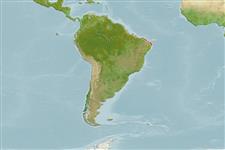>
Blenniiformes (Blennies) >
Dactyloscopidae (Sand stargazers)
Etymology: Platygillellus: Greek, platys = flat + Theodore Nicolas Gill (1837-1914) researcher of abyssal fishes and systematics (Ref. 45335); brasiliensis: Named for its distribution and probably endemic in Brazil..
Environment: milieu / climate zone / depth range / distribution range
Ökologie
seewasser demersal; tiefenbereich 1 - 2 m (Ref. 56973). Tropical
Southwest Atlantic: Brazil.
Size / Gewicht / Alter
Maturity: Lm ? range ? - ? cm
Max length : 4.1 cm SL Männchen/unbestimmt; (Ref. 56973); 4.0 cm SL (female)
Kurzbeschreibung
Morphologie | Morphometrie
Diagnosis: The dorsal finlet is fan-like and 3-spined, its height more than half of predorsal length, 58-84% (vs. 4-spined in P. smithi, low profile in P. rubrocinctus); first 2 spines of finlet more closely spaced than the 2nd and 3rd. Lateral line deflection is usually located below interspace between 14th and 15th dorsal fin elements. Upper lip fimbriae more numerous than those of lower lip. Base of pectoral fin usually naked or rarely with a single scale on its upper portion (Ref. 56973).
Known from shallow reefs; inhabits the margins of sand flats in small caves and below reef walls at depths of 1 to 6 meters; these areas are deposits of coarse gravel largely composed of f fragments of mollusc shells, crustaceans, corals, calcareous algae and sea urchin skeletons and spines. Found buried in the gravel, with just the eyes and the dorsal finlet exposed; it appears to 'swim' in the gravel; solitary or in groups. Associates with other sand-dwelling fishes such as Dactyloscopus tridigitatus, D. crossotus, Gillellus greyae, and toadfish Thallasophynne punctata; also an unidentified shrimp and juveniles of crabs (Callinectes sp.).
Life cycle and mating behavior
Geschlechtsreife | Fortpflanzung | Ablaichen | Eier | Fecundity | Larven
Feitoza, B.M., 2002. Platygillellus brasiliensis n. sp. (Perciformes: Dactyloscopidae), the third species of the genus from the Atlantic. aqua, J. Ichthyol. Aquat. Biol. 6(1):21-28. (Ref. 56973)
IUCN Rote Liste Status (Ref. 130435)
Bedrohung für Menschen
Harmless
Nutzung durch Menschen
Mehr Information
NamenSynonymeMetabolismusRäuberÖkotoxikologieFortpflanzungGeschlechtsreifeAblaichenSpawning aggregationFecundityEierEientwicklung
Alter/GrößeWachstumLänge-GewichtLänge-LängeLängenhäufigkeitenMorphometrieMorphologieLarvenLarven Pop.Dyn.RekrutierungDichteBRUVS
ReferenzenAquakulturAquakultur ProfilZuchtlinienGenetikElectrophoresesVererbbarkeitKrankheitenVerarbeitungNutrientsMass conversion
PartnerBilderStamps, Coins Misc.LauteCiguateraGeschwindigkeitSchwimmstilKiemenoberflächeOtolithsGehirngrößeSehfähigkeit
Tools
Zusatzinformationen
Download XML
Internet Quellen
Estimates based on models
Preferred temperature (Ref.
123201): 27 - 27.6, mean 27.5 °C (based on 44 cells).
Phylogenetic diversity index (Ref.
82804): PD
50 = 0.5156 [Uniqueness, from 0.5 = low to 2.0 = high].
Bayesian length-weight: a=0.00389 (0.00180 - 0.00842), b=3.12 (2.94 - 3.30), in cm total length, based on all LWR estimates for this body shape (Ref.
93245).
Trophic level (Ref.
69278): 4.0 ±0.6 se; based on size and trophs of closest relatives
Fishing Vulnerability (Ref.
59153): Low vulnerability (10 of 100).
